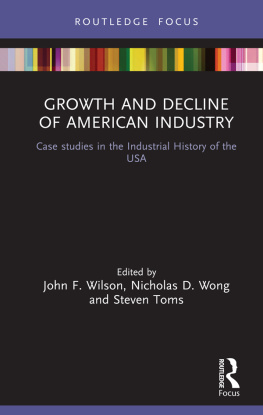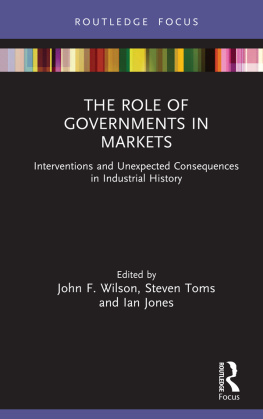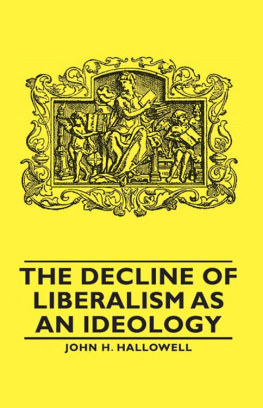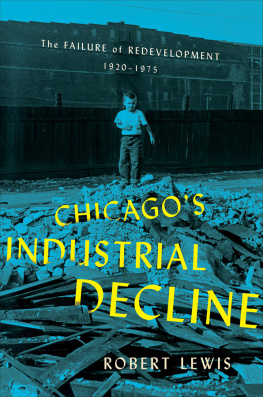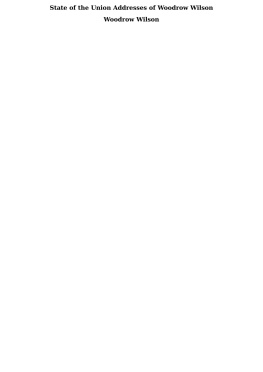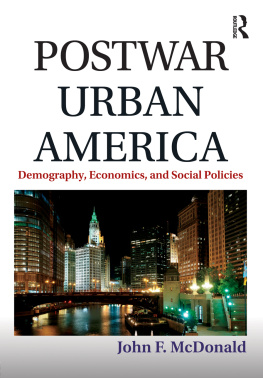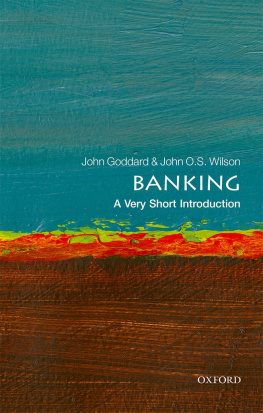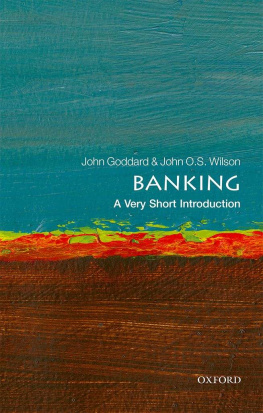John F. Wilson - Growth and Decline of American Industry
Here you can read online John F. Wilson - Growth and Decline of American Industry full text of the book (entire story) in english for free. Download pdf and epub, get meaning, cover and reviews about this ebook. year: 2020, publisher: Routledge, genre: Politics. Description of the work, (preface) as well as reviews are available. Best literature library LitArk.com created for fans of good reading and offers a wide selection of genres:
Romance novel
Science fiction
Adventure
Detective
Science
History
Home and family
Prose
Art
Politics
Computer
Non-fiction
Religion
Business
Children
Humor
Choose a favorite category and find really read worthwhile books. Enjoy immersion in the world of imagination, feel the emotions of the characters or learn something new for yourself, make an fascinating discovery.
- Book:Growth and Decline of American Industry
- Author:
- Publisher:Routledge
- Genre:
- Year:2020
- Rating:5 / 5
- Favourites:Add to favourites
- Your mark:
- 100
- 1
- 2
- 3
- 4
- 5
Growth and Decline of American Industry: summary, description and annotation
We offer to read an annotation, description, summary or preface (depends on what the author of the book "Growth and Decline of American Industry" wrote himself). If you haven't found the necessary information about the book — write in the comments, we will try to find it.
Growth and Decline of American Industry — read online for free the complete book (whole text) full work
Below is the text of the book, divided by pages. System saving the place of the last page read, allows you to conveniently read the book "Growth and Decline of American Industry" online for free, without having to search again every time where you left off. Put a bookmark, and you can go to the page where you finished reading at any time.
Font size:
Interval:
Bookmark:

Trying to keep the customers stratified
Steven W. Usselman
Historians seeking to shed light upon the murky subject of governmentbusiness relations in America face a fundamental challenge. Somehow they must bridge the chaotic realm of
The first generations of scholars who studied business regulation generally sidestepped this challenge. Presenting the history of regulation as a series of struggles between competing interests to control the course of legislation, they conflated political victories with regulatory outcomes. For the pioneering historians of the 1930s and 1940s, the establishment of regulatory agencies such as the Interstate Commerce Commission and the Federal Trade Commission provided a priori evidence that liberal democracy (The People) had triumphed over concentrated economic power (Big Business).
Arguments that business orchestrated the rise of federal regulation breathed new vigor into the study of business-government relations. One offshoot was a new spate of studies tracing the origins of regulatory statutes at the state and federal level. Many of these works emphasized the conflicting objectives of various interests in the business community. By portraying business as something other than a monolithic entity, such studies blunted the force of the revisionist argument. The legislative arena now appeared less like a stage for grand conflict between opposing forces and more like a forum for complex negotiation among diverse interests. Legislation itself was read more as evidence of compromise than of triumph. Yet, however subtle their portrayals, these studies remained focused on political outcomes rather than on the actual social and economic ramifications of regulation.
Such was not true in the case of another critic of the revisionist position, railroad historian Albro Martin.IBM.
The attempt to hold regulatory performance up to a standard of economic efficiency has become a hallmark of many of the best recent studies of governmentbusiness relations. In his important study Prophets of Regulation, for instance, historian Thomas K. McCraw used the economic analysis of business historian Alfred D. Chandler as a yardstick against which to measure some of the large-scale enterprise and preserved the advantages it could provide, while keeping an eye on the welfare of consumers.
By emphasizing the interplay between economic structure, government policy, and consumer welfare, McCraw has assembled perhaps our most sophisticated sustained analysis of business regulation across the span of American history. His work helps reorient our thinking, shifting attention away from specific political struggles and focusing it instead on the persistent issue of economic performance. Yet despite its obvious contributions, one might well question whether this analysis captures the full complexity of the story. With its stress upon the Chandlerian framework, which accentuates the importance of high-volume throughput and economies-of-scale, McCraws interpretation encourages us to frame our consideration of regulation narrowly in terms of efficiency and low prices. In recent years, business historians have questioned whether Chandlers account neglects important features of the corporate economy. Some have documented the persistent role of smaller firms and of economic sectors that fall outside the core of mass producers, settings where competition typically involves efforts to provide distinctive products rather than just low prices.
This paper seeks to meld this more dynamic conception of the corporation with the literature on governmentbusiness relations. It examines and compares the experiences of two Chandlerian industries railroading and computing during their first half century under federal regulation. The paper suggests that in both cases business managers and the regulatory community persistently wrestled with the difficult task of balancing the benefits of efficiency, which typically derived from routine and
Both of these platforms offered ample opportunities for sustained improvement that would yield greater efficiency. Consumers would reap the benefits in the form of greater power (measured in tonnage transported or data processed) at lower cost. Many of those benefits resulted from relentless pursuit of standardization. Uniformity yielded economy, in the true sense of the word.
There was more to these industries, however, than sustained accomplishment along well-defined axes of limited criteria. For in each case, improvements in the basic platform also opened possibilities to perform entirely novel operations. In the case of computing, such novelties typically have occurred in the readily recognizable form of applications software. All of us who have experienced the steady stream of upgrades in our word processing programs over the past two decades well understand that technical change in computing involves new features rather than a mere increase in speed. The computer software and services industries have long emphasized product differentiation and customized installations.
Opportunities for novelty of this sort were not nearly so rich, of course, in the case of railroading. The basic platform was far more rigid, and though the rail lines achieved impressive productivity gains during the late nineteenth century, improvements such as steel rails and more powerful locomotives offered nothing like the extraordinary gains in cost-performance ratio that the solid state revolution has made possible in electronic computing. All of these enterprises thrived at least in part by turning the utilitarian railroad toward a customized service; in that sense, they are analogous to software companies and service providers in the computer business.
To the extent that innovation of this sort involves IBM and Microsoft persistently faced accusations that their standards placed unnecessary constraints upon those wishing to perform customized operations. Not coincidentally, both firms reluctantly gravitated toward so-called open architectures capable of facilitating a wide variety of specialized applications devised by numerous independent suppliers.
As these brief comments suggest, a key element in the ongoing tradeoffs between uniformity and novelty involves the interface between platform providers and firms concerned with accommodating the specialized needs of particular consumers. Seldom has this boundary been sharply drawn. Technological interdependencies draw firms and consumers together in complex ways, and business strategies frequently converge. On many occasions, the critical interface has formed within the platform providers themselves, as their managers made trade-offs between the relative merits of pursuing further standardization versus the possibility of capturing greater returns by offering premium services. Even in these circumstances, however, the choices have always been made within a larger framework of public policy. Using instruments of rate regulation and antitrust, government has functioned as a watchdog, monitoring the critical boundaries that mediate the choices between uniformity-enhancing routine and product-differentiating innovation. Though government has hardly been unfailingly consistent or clear in its objectives, its focus has recurrently turned to the same fundamental challenge. Politicians and the regulatory community, like the firms they monitor, have struggled in their thinking and in their policies to conceive of the market not merely as a homogeneous mass seeking standard performance at lower cost, but as a collection of interests wishing to have their individual needs met through innovative service. They have tried, in other words, to keep the customers stratified.
Next pageFont size:
Interval:
Bookmark:
Similar books «Growth and Decline of American Industry»
Look at similar books to Growth and Decline of American Industry. We have selected literature similar in name and meaning in the hope of providing readers with more options to find new, interesting, not yet read works.
Discussion, reviews of the book Growth and Decline of American Industry and just readers' own opinions. Leave your comments, write what you think about the work, its meaning or the main characters. Specify what exactly you liked and what you didn't like, and why you think so.

